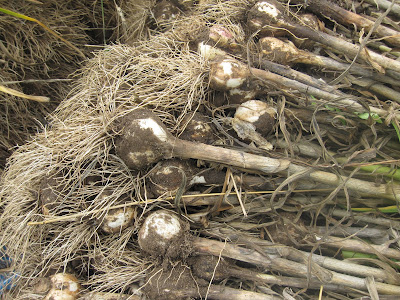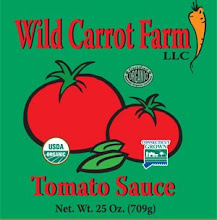 Our winter squash laying out in the greenhouse, curing.
Our winter squash laying out in the greenhouse, curing.Winter squash is the fall harvest storage vegetable. Winter squash will store three to six months, depending on the variety, in a cool, dry, well-ventilated area. All varieties are great for baking, roasting and pureeing. Once squash is cooked, it can be used in soups, main dishes, vegetable side dishes, even breads, muffins, custards & pies. Any type of mashed or pureed winter squash can be used in place of canned pumpkin.
Winter Squash is rich in vitamin A, beta-carotene, vitamin C, potassium and dietary fiber. It has powerful antioxidant and anti-inflammatory properties.
These are some of the USDA Certified Organic varieties you will find at our farm store and farmers' markets:
HONEY BEAR, a mini-acorn squash is just the right size halved for single servings. It is deliciously starchy and sweet.

ACORN SQUASH is a small, ribbed squash; it has a pale yellow flesh and is deliciously starchy and sweet.
It is delicious right from the garden and best eaten within 3 months of harvest. Acorn squash is ideal for baking, but can also be sauteed or steamed.
To bake simply cut acorn squash in half, remove any seeds, add butter and bake at 350 degrees 45 to 60 minutes until squash is tender. Store in a cool dry place such as a cellar.
KABOCHA is a Japanese variety, that refers most commonly to a squash of the buttercup type. It is like a buttercup without the "button" on the blossom end.
This squash has a green, bluish-gray (Grey Kabocha) or a deep orange (Scarlet Kabocha, pictured above) skin. The tender flesh is deep yellow to bright orange, smooth and sweet for baking, mashing & pies.

Usually a tear-drop shape, HUBBARD SQUASH are often used as a replacement for pumpkin. Hubbard squash are good for pies and purees.
Hubbard squash can be cooked whole, but are generally peeled and boiled, cut up and roasted, or cut small and steamed or sauteed. The yellow flesh of these tend to be very moist and longer cooking times in the oven are needed.
Hubbard squash, if in good condition initially, can be successfully stored six (6) months at 50 to 55 degrees F. with 70% relative humidity. Less rot will develop in the Hubbard Squash if stems are completely removed before storage.
 BUTTERNUT SQUASH usually have a tan skin. The "oranger" the color, the riper, drier, and sweeter the squash. The bright orange, moist flesh tastes best after a few weeks storage.
BUTTERNUT SQUASH usually have a tan skin. The "oranger" the color, the riper, drier, and sweeter the squash. The bright orange, moist flesh tastes best after a few weeks storage.
Butternut is a more watery squash and tastes somewhat similar to sweet potatoes. Its choice, fine-textured, deep-orange flesh has a sweet, nutty flavor. Some people say it is like butterscotch.
Butternut is a common squash used in making soups because it tends not to be stringy.
It has the longest storage potential of all squash; it will keep all winter.
 SPAGHETTI SQUASH
SPAGHETTI SQUASH is a small, watermelon shaped variety ranging size from 2 to 5 pounds or more. It has a golden-yellow, oval rind and a mild, nut-like flavor. When cooked, the flesh separates in strands that resemble spaghetti pasta.
The yellowest Spaghetti squash will be the ripest and best to eat. Although it may seem counterintuitive, larger Spaghetti squash are more flavorful than smaller ones.
To prepare Spaghetti squash, cut in half lengthwise and remove the seeds, then bake or boil it until tender. Once cooked, use a fork to rake out the "spaghetti-like" stringy flesh (all the way to the rind) and serve.
Spaghetti squash can be stored at room temperature for about a month. After cutting, wrap in plastic wrap and refrigerate up to two (2) days. Spaghetti squash also freezes well.
 BUTTERCUP SQUASH
BUTTERCUP SQUASH is one of the most common varieties of winter squash with a turban-shape (a flattish top and dark green skin), and normally heavy (weighing 3-5 pounds), with dense yellow-orange skin.
It has a sweet and creamy orange flesh. This squash is much sweeter than other winter varieties. Buttercup squash can be roasted, baked, mashed, pureed, steamed, simmered, or stuffed.
It can be used like pumpkin and can replace sweet potato in most recipes.
 SWEET DUMPLING
SWEET DUMPLING is a small, mildly sweet-tasting squash resembling a miniature pumpkin with its top pushed in. It has a cream-colored skin with green specks or can be multi-colored like the
Carnival (pictured left).
It has sweet and tender orange flesh and is a great size for stuffing and baking as individual servings. Sweet dumplings are tiny but great for roasting and presenting whole.
DELICATA is an heirloom variety and is one of the tastier winter squashes, with creamy pulp that tastes like corn and sweet potatoes.
Delicata can be baked or steamed. The thin skin in also edible.
 Our winter squash laying out in the greenhouse, curing.
Our winter squash laying out in the greenhouse, curing.
 BUTTERNUT SQUASH usually have a tan skin. The "oranger" the color, the riper, drier, and sweeter the squash. The bright orange, moist flesh tastes best after a few weeks storage.
BUTTERNUT SQUASH usually have a tan skin. The "oranger" the color, the riper, drier, and sweeter the squash. The bright orange, moist flesh tastes best after a few weeks storage.  SPAGHETTI SQUASH is a small, watermelon shaped variety ranging size from 2 to 5 pounds or more. It has a golden-yellow, oval rind and a mild, nut-like flavor. When cooked, the flesh separates in strands that resemble spaghetti pasta.
SPAGHETTI SQUASH is a small, watermelon shaped variety ranging size from 2 to 5 pounds or more. It has a golden-yellow, oval rind and a mild, nut-like flavor. When cooked, the flesh separates in strands that resemble spaghetti pasta. BUTTERCUP SQUASH is one of the most common varieties of winter squash with a turban-shape (a flattish top and dark green skin), and normally heavy (weighing 3-5 pounds), with dense yellow-orange skin.
BUTTERCUP SQUASH is one of the most common varieties of winter squash with a turban-shape (a flattish top and dark green skin), and normally heavy (weighing 3-5 pounds), with dense yellow-orange skin. SWEET DUMPLING is a small, mildly sweet-tasting squash resembling a miniature pumpkin with its top pushed in. It has a cream-colored skin with green specks or can be multi-colored like the Carnival (pictured left).
SWEET DUMPLING is a small, mildly sweet-tasting squash resembling a miniature pumpkin with its top pushed in. It has a cream-colored skin with green specks or can be multi-colored like the Carnival (pictured left).



.jpg)



 Fun Facts about Garlic:
Fun Facts about Garlic: 









.jpg)

 I used what I brought home with me to make an Asparagus Soup with Garlic Cream. This recipe is super simple to make and delicious!
I used what I brought home with me to make an Asparagus Soup with Garlic Cream. This recipe is super simple to make and delicious!


